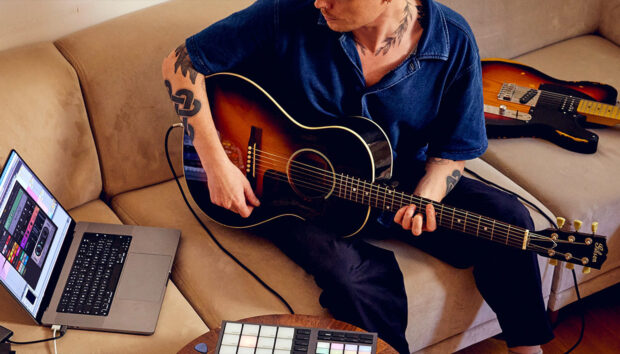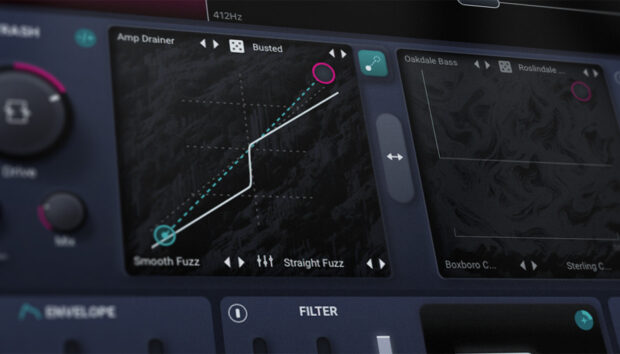
As a musical style, R&B can be a tricky beast to pin down, with many evolutions over the decades. Nevertheless, interesting chord shapes have always been a characteristic feature of the genre. If you want to achieve the jazzy sound of R&B chord progressions, it’ll come down to using extended chords, borrowed chords, chord inversions, and keyboard sounds that’ll get you that smooth and buttery sound characteristic of the genre. Let’s explore some of these topics in greater detail below.
Jump to these sections:
- Deconstruct your favorite R&B chord progressions
- Borrow chords from other scales
- Embellish your chords with extensions
- Use chord inversions
- Perform quick & easy transformations
Follow along with this tutorial using 40’s VERY OWN KEYS, and build your chords using tools like KOMPLETE keyboards or MASCHINE.
1. Deconstruct your favorite R&B chord progressions
If you already have a basic foundation of music theory and want to learn R&B chord progress a good place to start is to simply play along to a lot of R&B music.
You can use websites such as Chordify or Hooktheory to learn the chord progressions of your favorite songs. These sites catalog auto-generated and crowd-sourced chord progressions and show you the guitar or piano chord shapes as the songs play through, so you can learn about R&B piano chord progressions and R&B guitar chord progressions in real time.
Once you learn the chords of your favorite songs, you can study them to understand why they work as you’re learning how to use R&B chord progressions in your own songs. For example, let’s take the familiar major 3-chord riff from En Vogue’s “Dont Let Go (Love)” (F – Db – Eb), and change the order of the chords to Db – F – Eb, adjust the timing, and throw in an extra Cmin7 at the end of the sequence. The progression now has a totally different feel.
Let’s listen to the before-and-after.
2. Borrow chords from other scales
Using borrowed chords means to incorporate a chord in your chord progression that belongs to another key or mode. What keys and modes should you borrow from? Well, in R&B it’s common to borrow chords from the parallel minor or to switch to Dorian mode for a short period of time. The result is a different, yet compatible sound which is commonly used in Neo Soul, Jazz, R&B. Let’s take a look at what it would look like to borrow a chord from a parallel key.
Parallel chords are chords borrowed from a key parallel to the one your song is in. In music theory, parallel keys are defined as a major scale and a minor scale that share the same root note but a different scale.
For example, the parallel key of the C major scale is the C minor scale. So, when writing in the scale of C major, you can borrow chords from the C minor scale (or Eb major scale). The same goes for every major scale. The parallel key of D major is the D minor scale, E major is E minor, so on and so forth.
Let’s take a look at how this technique is used In the song “Best Part” by H.E.R. and Daniel Caesar.
The song uses chords from the D major key and borrows chords from the parallel key of D minor. Here are the chords:
Dmaj7 – Gmaj7 – Amin7 – Bbmaj7

As you can see, the song utilizes the D maj7 and G maj7 from the key of D and substitutes the V and VI chord with Am7 and B maj7 which belong to the key of D minor.
3. Embellish your chords with extensions
R&B gets its jazzy sound by incorporating extended chords. An extended chord is a basic triad that has notes added to it beyond the usual three notes. These added notes help add color and tonalities that are common in R&B music. You can turn a basic triad chord into an extended chord by adding every second note on a scale beyond the fifth. The extended chords are 7, 9, 11, and 13 chords. So you’ll typically see them notated as Cmaj7, or Cadd9, or Cmaj13 with the numbers representing the position of the added note relative to the root of the chord. So a Cmaj 7th is a basic C major triad that adds a note 7 steps away from C within the same scale. A Dmin9 is a D minor triad that adds a note 9 steps away from D within the scale. The same logic applies to other extended chords.
The basic guidelines to creating extended chords are:
- 7th chord = triad + 7th
- 9th chord = triad + 7th + 9th
- 11th = triad + 7th + 9th + 11th
- 13th = triad + 7th + 9th + 11th + 13th
Extensions are used to embellish simple chords, and there are various ways to play them. The notes don’t always need to be played above a triad, and in most cases actually sound better when either clustered together or spaced out across several octaves.
Let’s take a closer look at the kind of chord shapes typical of R&B music, which are very rarely simple triads. Take as an example, the notes of C – E – G making up a chord of C major.

You are far more likely to hear a 7th (C – E – G – B), dominant 7th (C – E – G – Bb) or ‘extensions’ such as 9ths, 11ths and 13ths.


4. Use chord inversions
A chord ‘inversion’ is the rearrangement of notes in a chord. The term used to describe a chord is played and has any note other than the root note down at the bass. For example, our previous Cmaj7 of C – E – G – B would look like E – G – B – C in a 1st inversion.


Don’t get too hung up on the terminology, just be aware that playing inversions can quickly invigorate an otherwise simple chord sequence. This is especially true when writing chord sequences where the bass note is the same from one chord to the next, making for a more cohesive sounding progression. In fact, holding notes over from one chord to another always sounds rather nice.
5. Perform quick and easy chord transformations
Once you understand chord inversions, you can have an easier time with chord transformations. A chord transformation occurs when the voicing of a chord is altered to transform that chord into a different chord. Chord transformations can be used to minimize the work you do when shifting from one chord to the next. For example, a C major chord (C–E-G) easily transforms into an inverted E minor chord by shifting the C note down one semitone (B-E-G). In this scenario, a chord transformation saves you from having to shift your entire hand up four semitones to play a conventional E minor chord (E-G-B).
Transformations are useful in R&B because they reduce the work required to play complex extended chords. Instead, you can play clustered chords and shift between chords with minimal hand movement.
If you haven’t yet grasped the technicalities of chord transformations and progressions, don’t worry. Here are some easy ways to bring simple triads into the R&B realm. We’re demonstrating these examples in C major and A minor as they’re the simplest to notate, but you can transpose the chords into any root key you wish. We’ll be using 40s VERY OWN KEYS to demonstrate these chords, which helps give these chords the signature R&B sound.

One of the most recognisable major-key R&B chord progressions is C – E – G – B – D (Cmaj9) into B – D – F# – A (Bmin7). This is a great starting point for a chord progression in your R&B song.


Spice up an A minor triad (A – C – E) by adding a G above to create Amin7, B above to create Amin9, or a D below as the 11th note of the extension, where it becomes the bass note.



This technique can be explained in a different way; creating a minor 13th chord by playing a minor triad with your left hand (A – C – E), and a major triad with your right hand, beginning 10 semitones higher (G – B – D). Leave out the middle note of the upper triad for a more open sound.

Taking this a step further, you can create neo-soul style clusters by taking any 7th, 9th, 11th and 13th notes, usually played above the triad, and move them down an octave. Try A – C – E – G – B and move the top B down an octave to become A – B – C – E – G.


In the same way, try doubling notes of the chord, moving them up or down an octave. As a rule of thumb, lower notes should be placed further apart and higher notes closer together.

Some minor 7th and major chords are similar, with many common notes. These two chord types can be interchanged to add interest to your compositions. For example, Amin7 (A – C – E – G) and Cmaj (C – E – G).


Almost any kind of minor chord extension sounds good when it progresses to a major chord extension placed 4 semitones lower. Almost the same notes are used, so it’s easy to play. For example A – C – E – G – B transitioning to F – A – C – E – G. In a similar way, move down the scale by 3 more semitones into another minor chord extension: D – F – A – C – E. If you fancy it, resolve into a nice Emin7: E – G – B – D


Take your R&B chord progressions further
Once you’ve mastered the basics of triads, extensions, inversions and other chord shapes, the R&B genre is your playground. Have some fun with production; assigning chords to different instruments, weaving bass lines through your progressions, and synth parts that build on chord progressions with interesting top-line melodies. Don’t forget that almost all of the chord theories outlined in this feature can be applied to R&B vocal harmonies too… but that’s a huge topic for another day. If you haven’t already, start exploring some sampled instruments to use when planning your chord progressions.















